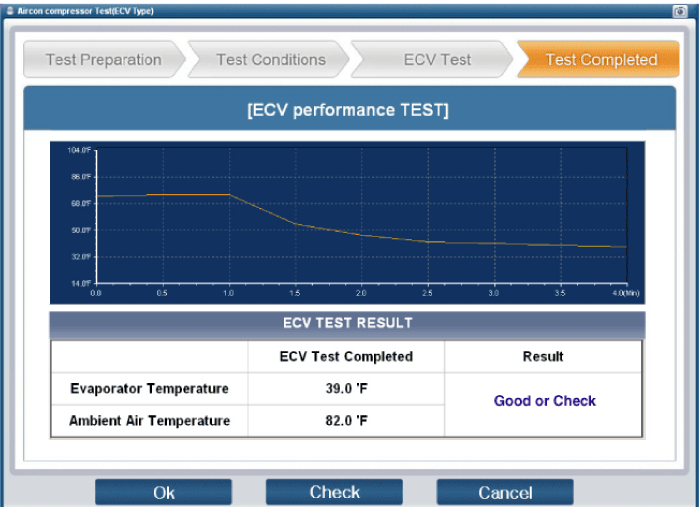Kia Cadenza: Air Conditioning System / Compressor Repair procedures
Kia Cadenza YG 2016-2025 Service Manual / Heating,Ventilation, Air Conditioning / Air Conditioning System / Compressor Repair procedures
| Removal |
| 1. |
If the compressor is marginally operable, run the engine at
idle speed, and let the air conditioning work for a few minutes, then
shut the engine off. |
| 2. |
Disconnect the negative cable from the battery. |
| 3. |
Recover the refrigerant with a recovery/charging station. |
| 4. |
Loosen the drive belt.(Refer to EM group-Drive belt) |
| 5. |
Remove the bolts, then disconnect the suction line (A) and discharge line (B) from the compressor.
Plug or cap the lines immediately after disconnecting them to avoid moisture and dust contamination.
|
| 6. |
Remove the engine room front under cover (A) by loosening the mounting bolts.
|
| 7. |
Remove the engine room right side under cover (A) by loosening the mounting bolts.
|
| 8. |
6. Disconnect the compressor clutch connector (A), and then remove 4 mounting bolts and the compressor(B).
|
| Installation |
| 1. |
Make sure of the length of compressor mounting bolts, and then tighten it A→B→C→D order.
|
| 2. |
Install in the reverse order of removal, and note these items
|
| Inspection |
| 1. |
Check the plated parts of the limiter assembly (A) for color
changes, peeling or other damage. If there is damage, replace the
limiter assembly. |
| 2. |
Check the pulley (B) bearing play and drag by rotating the
pulley by hand. Replace the limiter assembly with a new one if it is
noisy or has excessive play/drag.
|
| External Control Valve Compressor Inspection (GDS) |
Compressor type: Fixed type compressor, External control valve, Internal control valve.
In cases of fixed type and internal control valve, it is possible to inspect compressor''s operation with clutch noise.
When it comes to External control valve, however, it cannot be checked in this way bacause it doesn''t have a clutch.
So, ECV should be inspected with GDS as below.
| 1. |
Connect GDS to the vehicle and select ''Aircon Compressor Test(ECV type)''
[ECV1]
|
| 2. |
Make the vehicle ready as the GDS instruction on the monitor. (Turn off A/C ''switch'' only)
[ECV2]
[ECV3]
|
| 3. |
Check if other DTC codes are found before inspect ECV
compressor. If so, solve that problems first. If not, press ''OK''
button to continue.
[ECV4]
|
| 4. |
Start inspection
[ECV5]
[ECV6]
|
| 5. |
Check the result of inspection.
[ECV7]
[ECV8]
|
| 6. |
If the result shows "Check" , click "Check" and follow the instruction.
|
| 7. |
Inspect ECV again from the first step. |
| Disassembly |
| 1. |
Disconnect the negative cable from the battery. |
| 2. |
Remove the front right tire(A) from front hub.
|
| 3. |
Separate the front portion of the front wheel guard (A) from the wheel base.
|
| 4. |
Remove the engine room front under cover (A) by loosening the mounting bolts.
|
| 5. |
Remove the center bolt (A) while holding the limiter assembly
with a commercially available limiter assembly bolt remover, Special
tool number 09977-3R000.
|
| 6. |
Remove the dlimuter assembly (A) and shim (gap washer), taking care not to lose the shims.
|
| 7. |
Remove the drive belt.
(Refer to EM group - "Timing Chain") |
| 8. |
Remove retainer ring (A) with retainer ring pliers and then remove the pulley(B).
|
| 9. |
Reassemble the compressor clutch in the reverse order of disassembly, and note these items :
|
 Compressor Components and Components Location
Compressor Components and Components Location
Components
1. Screw2. Blot3. Limiter Assembly4. Retainer Ring5. Pulley6. Compressor Assembly
...
 Condenser Components and Components Location
Condenser Components and Components Location
Component Location
...
Other information:
Kia Cadenza YG 2016-2025 Service Manual: Rear Door Components and Components Location
Components 1. Rear door trim2. Rear inside handle cap3. Rear door belt inner weatherstrip4. Rear door side weatherstrip mounting moulding5. Rear door belt outside weatherstrip6. Rear door frame moulding7. Rear door panel8. Rear door seal9. Rear door DIV channel10. Rear door frame rear moulding ...
Kia Cadenza YG 2016-2025 Service Manual: Audio Remote Control Repair procedures
Inspection [Steering Remote Control Switch] 1. Check the audio remote control switch for resistance between terminals in each switch position. [Audio (LH)] SwitchConnectorterminalResistance(±5%)Seek up2-7430 ΩSeek down2-71.1 kΩMode2-72.11 kΩMute2-73.11 kΩVolume up2-74.61 kΩVolume ...
Copyright © www.kcadenzavg.com 2017-2025
























